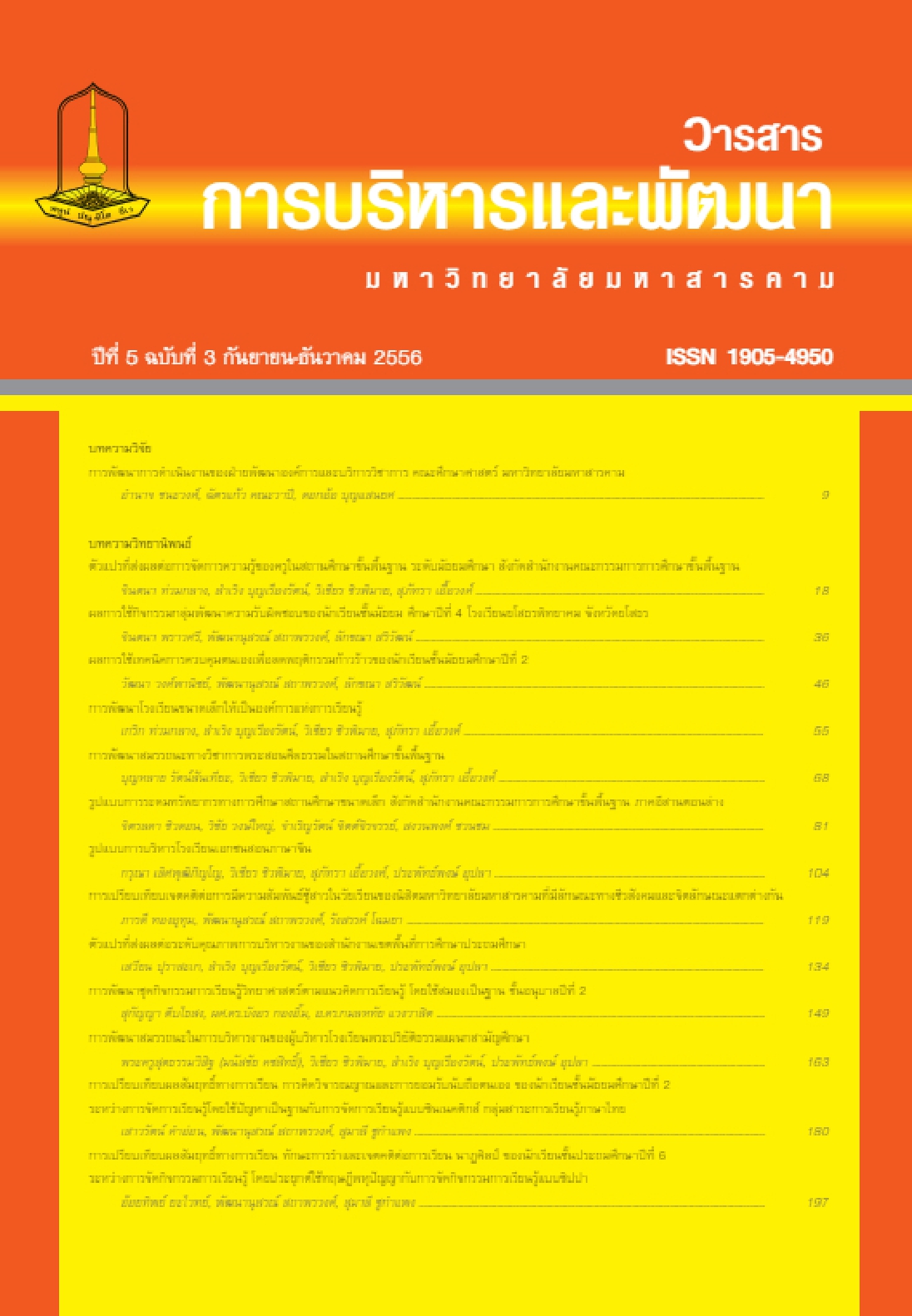A Model of Educational Resource Mobilization of Small Schools under the Office of Basic Educational Commission in Lower Northeastern Region
Main Article Content
Abstract
The objectives of this research were (1) to construct a model and (2) to evaluate the efficiency of the model of educational resource mobilization of small schools under the Office of Basic Educational Commission in Lower Northeastern Region. The methodology is of 6 stages, namely (1) to study the documents and the research concerned with Educational Resource Mobilization covering 4 main types of personal, financial, learning resource, and educational device and technological resource mobilization, and then to interview the connoisseurs as the basic educational administrators, teachers of the small schools under the Office as such for integrating the research conceptual framework, (2) to construct the drafted model, (3) to evaluate the quality of the drafted model by means of the first round of focus group discussion, (4) to improve that model as commented by those connoisseurs, (5) to evaluate the efficiency of the model by asking 544 administrators and teachers of those schools as above mentioned and then compute the data by application of mean, and standard deviation, and (6) to affirm the model by the second round of focus group discussion.
The research findings were as follows:The model of educational resource mobilization of small schools under the Office of Basic Educational Commission in Lower Northeastern Region covering (1) the personal resource mobilization with the practical guideline of developing the qualified administrators and teachers including students, promoting the institutional products, volunteering mind, participating of parents, community and the sectors concerned as well as school networking, and also of local intellectual integration for educational management, (2) financial resource mobilization with the guidelines for planning the financial mobilization emphasizing on participating, using the finance for school work producing to make the parents, community and the public believe, well relating with community, and mobilizing the finance resource transparently, (3) learning resource mobilization with the guidelines of planning with the community to set the learning center within the institutions, collecting as well as preserving data and learning information for institutions and community by means of precise participating, enhancing the learning process based upon the learning resource mobilizing, and (4) educational device and technological resource mobilization with the guidelines of constructing the plan, project, activities based upon the needs of the educational materials, and administrators’ technological leadership, opening the school board committee participate in material management, trying to allocate or to have material provision, donation for a distance learning through satellite learning from the Distance Learning Foundation and other material from various sectors both state or private ones.
2. To evaluate the efficiency of model of educational resource mobilization of small schools under the Office of Basic Educational Commission in Lower Northeastern Region, it was found that the model has the efficiency as a whole in the high level.
Downloads
Article Details
References
Attakamanon, Pirat and Chokvarawattanakorn, Mattana. (2005). An Administrators’Training: A Community and Local Educational Enhancing for Educational Revolution ,2nd Edition. Bangkok: Chutthong Printing.
Bangmo, Somkid. (2009). Training and Conference Techniques. Bangkok: Vittayapat Printing.
Foundation of Distance Satellite. (2006). A Guideline for the Distanced Satellite Education. Bangkok: Ammarin Printing and Publication.
Kampeerapakorn, Preecha. (2002). “ Idea of Educational Resource Management,” in Resource Educational Management Unit 1-8. Nontha Buri: Sukhothaithammathirat Open University.
Kampeerapakorn, Preecha and Others. (2002). “Educational Material Management,” in Educational Material Management Unit 9-15. Nontha Buri: Sukhothaithammathirat Open University.
Kongthiang, Somsak. (2009). “Educational Resource ” in Teacher Professional Encyclopedia for the King’ s 80th Birthday Anniversary. Bangkok: The Teacher’Council of Thailand..
Ministry of Education. (2010). A Research Report on The Follow-Up for Evaluation of Educational Upgrading Based upon Educational Expenditure Per Capita of Basic Educational Students. Bangkok: Thailand Co-operative Printing.
Naowanon, Adisorn. (2009). Curriculum and Basic Education Managemnent. Nakhon Ratchasia: Faculty of Education, Nakhon Ragchasima Rajabhat University.
Office for National Education Standards and Quality Assessments (Public Organization). (2547). Education Act B.E. 2542 (1999) and Amendment (Second National Education Act B.E. 2545 (2002). Bangkok: Chutthong Printing.
Office of the Basic Education Commission. (2011). Holistic Educational Operation of Small Schools for the Second Decade Educational Revolution. Bangkok: Bureau of Policy and Basic Plan.
Office of the Basic Education Commission. (2007). A Guideline for Project Management for Upgrading Small Schools. Bangkok: Bureau of Policy and Basic Plan.
Office of the Basic Education Commission. (2009). Strategic Plan for Small School Development B.E. 2551-2553 (2009-2010). Bangkok: Bureau of Policy and Basic Plan.
Office of National Elementary Education. (2007). Learning Resource within Schools and Community. Bangkok: Religious Affairs Printing.
Ramkhamhaeng University. (2005). Seminar Papers on Educational Administration. Bangkok: Faculty of Education, Ramkhamhaeng University.
Rakwichitkul, Nareerat. (2006). Coures Handout Fund Raising for Schools. Mahasarakam: Faculty of Education, Mahasarakam University.
Sinthukhet, Penchan. (2011). Interviewed by Jitlada Sewdon at Nong E-lor School under the Office of Chaiyaphum Primary Educational Service Area 3 on July 26, 2011
Tapsuwan, Suda. (2009). Handouts of Educational Seminar. Nakhon Ratchasima: Faculty of Education, Vongchavalitkul University.
Visalaporn, Sermsak. (1998). “From Ramayana to Evaluation,” in Journal of Education of Srinakharinwirot University, 11 (1): 11.


